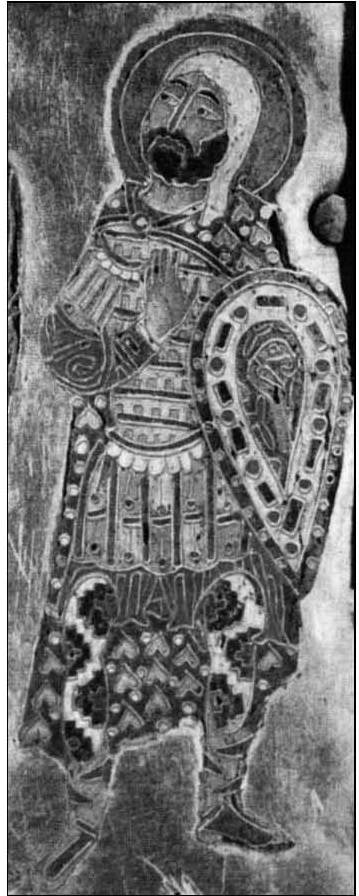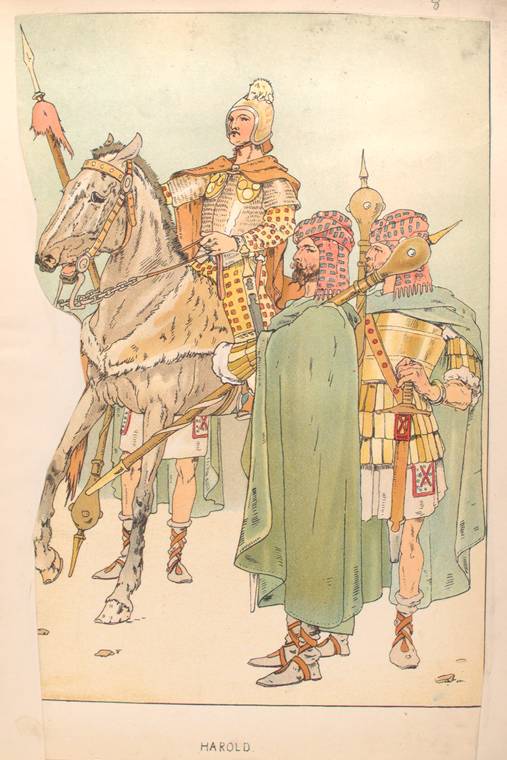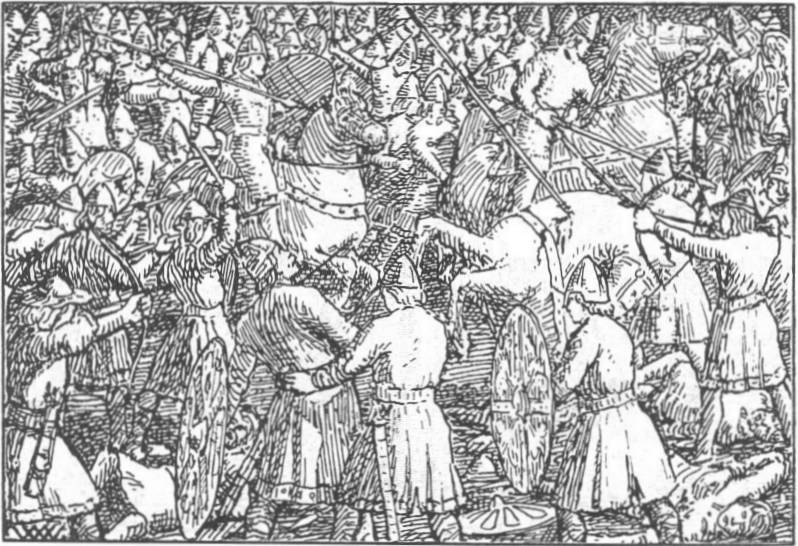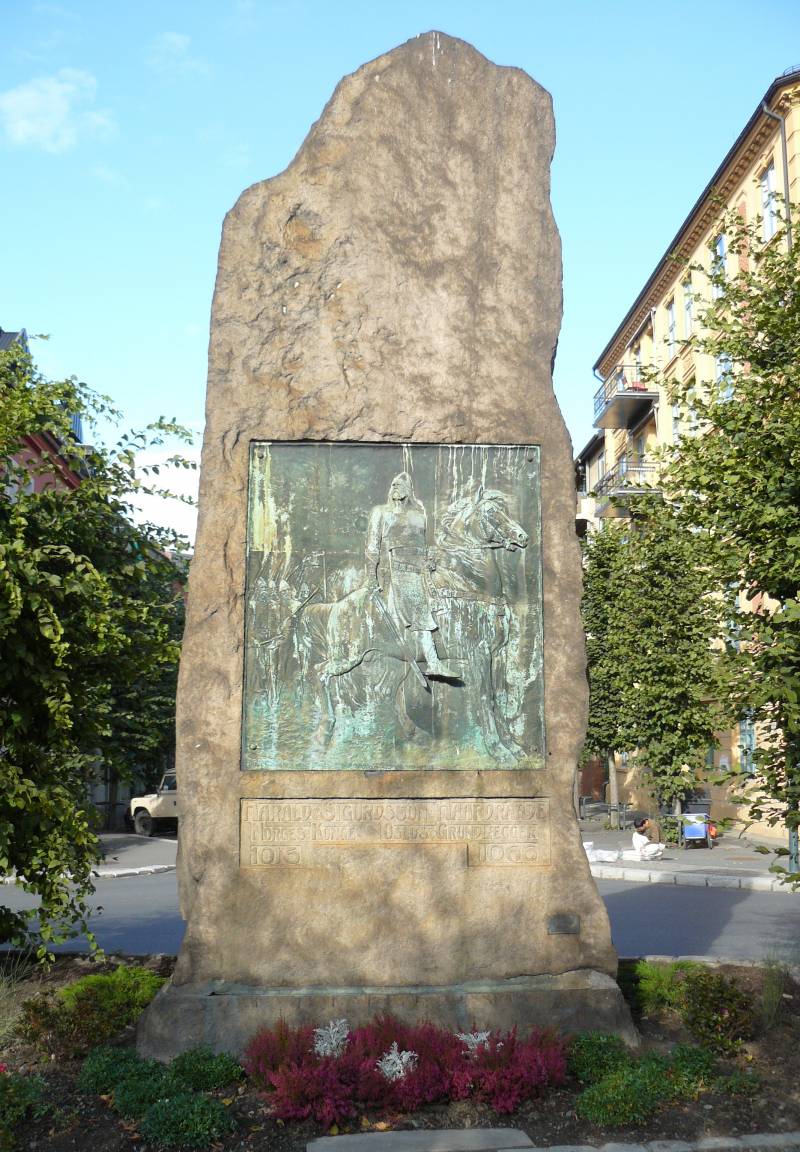Forge frames. Part of 1. Star of the Varangian Guard № 1
The great Etheriarchs and Akolufs led military units and formations in different theaters. So, Feoktist in 30's. XI century. acted in Syria, and Michael in the middle of the same century - on the Pecheneg front and in Armenia. Lower rank officers such as Harald Hardrada and Rangvald fought in Sicily and in Asia around the same period. The state trusted the competence of warang officers, handing them the command of various groups of different composition in all theaters of the empire.

1. Varangian officer
Placing the officers of the Varangian Guard at the head of the army units, basileus strengthened control over the entire army. Having acquired a rich combat experience, officers of Varangi often occupied significant positions in the military-administrative structure of their national states. The most striking example is, of course, Harald Hardrada (Sigurdson - that is, Grozny), the most famous Varangian Guardsman of Byzantium, the future king of Norway and the failed king of England.
The Scandinavian sagas are the most important source of information about persons who served in the Varangian Guard of Byzantium. Significant as sources have runic inscriptions. Such inscriptions on the gravestones of the Varangian warriors and leaders briefly describe the fate of the warriors who distinguished themselves in a foreign land, who returned to rest in their native land. They tell us about the adventures and the most important achievements of such soldiers of fortune.
When the son of King of Eastern Norway, Sigurd Pig, and the youngest half brother of Norway, Olaf II, young Harald were only 15 years old, Olaf died defending his throne from Knut the Great. Harald participated in the battle of 1030 Styklastadir, was wounded in it, and then left Norway. Having formed a detachment of exiles like him, in 1031, Harald arrived in Russia, where he entered the service of the Kiev Grand Prince Yaroslav the Wise.
After serving 3 of the year, in 1034, the Kiev combatant Harald with his squadron (about 500 fighters) arrive in Byzantium and enter the Varangian Guard. The motives of the young Norwegian - the desire for military exploits and the desire to get rich. The young Varyag quickly proved himself in combat conditions, winning the respect of the Warangs. As Harald himself noted, by the time he entered the Varangian Guard, he was a sufficiently trained warrior: he knew “eight kinds” of exercises, knew how to fight bravely, knew the art of riding, knew how to swim, run on skates, throw a spear and row [Jackson T.N. Icelandic Royal Sagas on Eastern Europe (mid-XI - mid-XIII cent.). M., 2000. T.3. C. 257].
The source notes that the "Land of the Greeks" was ruled by Emperor Michael Calafat and Empress Zoya. Harald, having met with the latter, and entered the service. And soon Harald became the "leader of all Wering."
European chronicler Adam of Bremen speaks about the arrival of Harald. The sagas point out that at first, for security reasons, Harald did not identify himself with his real name and did not disclose his origin by taking the name Nordbrikt.
K. Kekavmen in his Councils and the stories of the commander reports on the presence of Harald in the empire. An eyewitness noted that the young Varyag brought with him 500 brave warriors, was, as expected, adopted by the basil, who sent Harald to Sicily. Having arrived in Sicily, the Varangians performed “great feats” there. After the conquest of Sicily, Harald was awarded the rank of manglabit. After the Delyan mutiny in Bulgaria, Harald and his warriors, together with the basil, participated in the Bulgarian campaign, having accomplished deeds worthy of their "courage and nobility." After the pacification of Bulgaria, Vasilev granted Harald the rank of a spafar candidate. But, as noted by K. Kekavmen, after the death of the emperor and his nephew, Harald decided to leave home. The new sovereign Konstantin Monomah did not want to part with Harald, detaining the latter. But the manglabite and spafarok candidate could run and reign in his homeland. Moreover, even becoming king, he remained loyal to the emperor and friendship with Byzantium [Kekavmen K. Tips and Stories. SPb., 2003. C. 300-301].
Being 10 years in the service of the empire, Harald participated in a number of campaigns and battles.
Here are the main milestones of his Byzantine service:
1034 - 1036 - campaigns against the Syrian and Asia Minor pirates;
1035 - 1037 - trips to Mesopotamia and Syria (in 1036 the city of Harald visited Jerusalem, reached the Jordan, worshiped the Holy Cross and the Holy Sepulcher);
1036 - 1040 - participation in the Sicilian campaign (the Varangians acted under the general command of a talented commander - Italian cathep George Maniak; on his return from Sicily, Harald received the rank of manglebita), and this time is the golden period (literally and figuratively) in the life of the young Scandinavian (Harald in his Ode remembered these days of "our magnificence") [Jackson T.N. Decree. cit]);
1041 was involved in the suppression of the uprising of Peter Delyan in Bulgaria (according to sagas and chronicles, Harald personally killed the Bulgarian tsar in the battle, allegedly becoming the commander of the whole Varyag guard; this is mentioned by K. Kekavmen, the runic inscription on the Pirei lion notes the name of Harald the High; according to the results of the Bulgarian campaign, the future king becomes a spafar candidate).

2. Harald Hardrada. Fig. from the Vinkuizhen collection.
Still worth noting the average level of titles, which was awarded to Harald in Byzantium. K. Kekavmen, expressing the tendencies of the established practice of the empire, notes that it is not worthwhile to confer large titles on foreigners and trust them in high positions - this humiliates the indigenous Romans. After all, according to Byzantine logic, if a foreigner is honored with a higher title than a spa-candidate, he will become careless and will not faithfully serve the emperor. [Kekavmen K. Decree. cit. C. 295].
In 1042, Mr. Harald and his unit took an active part in the coup — Michael V Calafat was overthrown and then blinded. As the Byzantine writer G. G. Litavrin noted, from the very beginning of the new reign, the emperor Konstantin Monomakh showed distrust to the Varangians and the Russians, because they faithfully served the hated Paflagonons. And considering the fact that Harald, among other things, was a friend of Yaroslav the Wise (with whom Konstantin Monomakh had a difficult relationship at once, ended in an open military clash in 1043), the accusations made by the emperor against Hardrada are not surprising. The subject of the charges is misappropriation of state funds.
Being in prison along with two comrades (Ulv Ospakson and Halldor Snorrason), Harald was able to escape from Constantinople. Together with him, his cellmates and many soldiers from his unit fled. The Varangians escaped on Harald’s ship (since the Byzantines blocked the Golden Horn Bay with a chain, when the ship approached the latter, people quickly ran across the stern, and the nose rose above the chain, and then ran over the chain). According to one legend, the reason for the arrest of Harald was not the embezzlement, but the love of Mary for him - the niece of Empress Zoya.
The fugitives found shelter in Kiev.
In 1043, Yaroslav made a march on Constantinople — Harald and the Prince of Novgorod, the son of the Grand Duke, led the operation. In 1046, peace was concluded.
In the winter of 1044, Harald married Elizabeth Yaroslavna, the daughter of Yaroslav the Wise. The former officer of Varanga and the future king of Norway had to make a lot of efforts to win the love of the girl. Harald himself, speaking in Ode about his skills, skills and military achievements, complains in every quatrain that "not nice Russian beauty."
Harald fought in all Byzantine theaters - in Sicily, in Mesopotamia, in Syria and Palestine. Over the years of service, he obtained enormous values (in gold and precious stones) - and for a number of years he sent some of his mining to his friend and future test, Yaroslav the Wise. In his saga, Harald also focuses on the fact that he took a lot of gold, valuables and precious stones and that all the surplus of these riches, all that was not needed at the moment, he personally and the army, he sent with trusted people to Kiev, deposited to the king karitsleu. And at hand, Yaroslav accumulated enormous wealth - after all, Harald fought in the richest regions, capturing 80 cities [Jackson T.N. Decree. cit. C. 114-115].
A very interesting question is about the property sent for storage to Yaroslav. According to Norwegian law, the wealth gained in the Byzantine service, Harald should not be sent home. Article 47 of the “Laws of Gulatinga” established that the person leaving Norway could determine the person who would manage his property - but only for the 3-year period. After 3 years, all his property automatically went to the heirs, and if he left for the Byzantine Empire, the heirs acquired the rights to this property immediately. And the help of Yaroslav, who accepted, kept and returned his property to the young Norwegian, was invaluable.
Returning to his homeland after the fruitful Byzantine service, having acquired great combat experience, Harald began to implement his strategic plans. Trophy and Byzantine gold became the initial capital for their implementation.
In 1045, at the head of the army, Harald ended up in Sweden, becoming a threat to his nephew, King of Denmark and Norway, Magnus. The latter in 1046 made Harald his Norwegian co-ruler. A year later, before his death, he proclaimed his heirs: in Norway - Harald III, and in Denmark - Sven II.
Harald started a war with Sven for the Danish throne. The Danes suffered regular defeats, the Norwegian ships annually destroyed coastal areas. In 1050, Harald defeated Denmark’s main shopping center, Hedeby. In 1062, in a naval battle at the mouth of the r. Nissan was defeated Sven's fleet. But, despite all the victories, Denmark could not be conquered - the population supported Sven. In 1064, Mr. Sven and Harald made peace - the latter refused to claim the Danish throne.
In addition to the bloody war with Denmark, in 1063 - 1065. a war with Sweden took place - the last king supported the opposition Harald Yarlov. In 1063, in the battle of Venerne, Harald defeated the Swedes and Upland rebels.
In domestic policy, Harald was a tough centralizer, and during his reign in Norway, Christianity finally became fixed. Hardrada also took care of the development of trade - it was he who founded in 1048 the trade settlement of Oslo, the future capital of Norway.
Harald Hardrada died 25. 09. 1066 in the battle of Stamford Bridge - near the city of York. The troops of the former officer of the Varyazh Guard converged with the army of the English king Harold Godwinson. In the last campaign, Hardrada was accompanied by his faithful wife Elizaveta Yaroslavna, both daughters and son Olaf (the eldest son was left in Norway and proclaimed king). After disembarking about 15000 warriors (who arrived on 300 ships) in Northern England, Harald defeated the first British troops met on September at Fulford. And after 20 days at Stamford Bridge, the Norwegian king received a mortal wound (an arrow pierced his throat), and his troops were defeated.

3. The death of Harald at Stamford Bridge.
So the most famous commander of the Varangian Guard finished his life path. Finance, combat and organizational experience acquired in the service of the Byzantine Empire, he had enough to become king-unifier of Norway. It is not known how the fate of England could have been, if not that fatal arrow. Hardrada probably would have worn 2 royal crowns, while William the Conqueror wore none. And on the English throne after the death of Hardrada, his descendants would reign — monarchs, in whose veins Yaroslav the Wise's blood flowed.
From the moment he arrived in the empire, Harald immediately took up an officer position - commanding his unit in Varangi. In the future, he earned the ranks of manglabita and spafarokandida.
Harald Hardrada stayed in stories not only as the king of Norway, the “last viking” and the founder of Oslo, but also as one of the fantastically rich people of his time. Wealth was acquired by him through merit and personal effort. The source of the wealth of Harald was well known. So, Adam of Bremen noted that Harald could save him, becoming a warrior of the emperor, having gone through many battles at sea and on land, and became famous for his personal valor. However, besides such sources of wealth as war booty, imperial gifts, 3-multiple participation in imperial coronations and 3-multiple realization of the custom to take after the death of the emperor what they want, it was significant that after the overthrow of Michael Calafat Harald could be among the crowds that stormed the imperial palace — by taking part in a process called the robbery of the royal chambers called the saga.
4. Monument to Harald - the founder of Oslo.
There are relevant points of view of historians regarding the possibility of obtaining additional income by Varangas: first, the Vikings could take part in the process of collecting taxes in areas where ordinary assemblers could not cope without the support of the military, and secondly, being a long period, stationed in the respective province , mercenaries could receive a special tax from the local population.
Anyway, Harald had more than enough opportunities for personal enrichment, in addition to participating in hostilities.
And if to the possibility of acquiring significant funds add a reliable channel for their preservation, then it is clear that Harald could not help but become rich. Returning to Russia, he took away not only the gold and jewels previously sent to Yaroslav from Byzantium, but also the daughter of a friend — his beloved wife Elizabeth Yaroslavna.
It is worth remembering that Harald Hardrada, in addition to being an officer of the Byzantine imperial army, was the commander of the Russian troops, and later the son-in-law of the Kiev grand duke, and belonged to the previously mentioned Varangian Rusas. It is significant that almost 10 anniversary of the service of the Byzantine Empire and 7 years of service Harald of Kievan Rus.
To be continued

Information